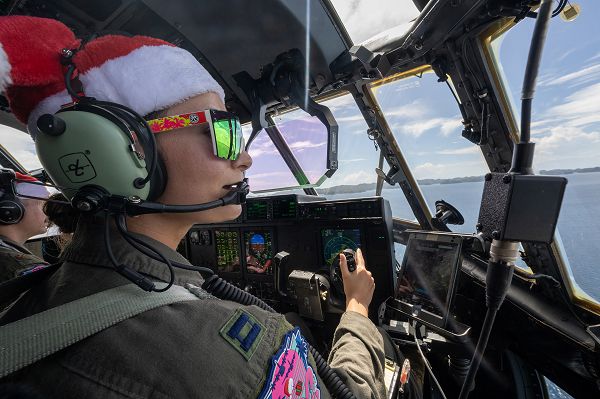- Details
- Hits: 284

Fleet Activities Sasebo, Japan. (December 10, 2023): When serving thousands of miles from home at this sprawling Navy base, families look forward to Christmas in the Park, a 75-year tradition bringing Sailors and their families together with the local Sasebo community. In this photo by MC2 Quinton A. Lee, Japanese and American families gather at CFAS Nimitz Park to enjoy a night of music, refreshments, and camaraderie. The base is home to 6,000 active-duty personnel, their dependents, and civilian contractors.
One of the most difficult challenges facing military families is how to adjust to different cultures, languages, customs, and surroundings. On the other hand, the chance to meet new people and travel to exotic places is one of the greatest benefits of serving. There are currently over 80,000 American personnel stationed at various bases around Japan which presents a significant chance to share cultures and develop ties that last a lifetime. The Sailors and their families at Sasebo will bring home fond memories of celebrating Christmas with their Japanese hosts.
- Details
- Hits: 317
America Sends Holiday Cheer From The Skies

Koror Island, Republic of Palau. (December 11, 2023): For the people of this tiny island, giant warplanes overhead mean only one thing, a shower of American generosity falling from the skies. In this photo by Yasuo Osakabe, U.S. Air Force Captain Miranda Bapty flies over Palau during Operation Christmas Drop, the Department of Defense’s longest running humanitarian and disaster relief mission. Every year, the 36th Expeditionary Airlift Squadron flies its C-130J Super Hercules aircraft over Palau to deliver bundles containing donated non-perishable food, fishing supplies, schoolbooks, and toys for the islands' children.
Operation Christmas Drop began in 1952 after U.S. B-29 Superfortress crews saw islanders waving at them from the island of Kapingamarangi, 3,500 miles southwest of Hawaii. In the spirit of Christmas, the aircrew dropped a bundle of supplies attached to a parachute to the islanders below, giving the operation its name. Today, air drop operations include more than 50 islands throughout the Pacific spanning distances nearly as wide as the United States.
A week before the drop, volunteer Airmen, Soldiers, Sailors, Marines, and civilians assist in sorting the donations while parachute riggers built dozens of boxes to hold the materials securely for the air drops. During the actual flights, air crews were linked to the villages via ham radio as they flew overhead to drop their bundles at specified drop zones. These humanitarian operations have the added benefit of giving air crew invaluable real-world training and experience in conducting airdrops. This year, these crews provided critical supplies to 56 Micronesian islands impacting about 20,000 people.
Flying forces from the U.S. Air Force, the Japan Air Self-Defense Force, the Republic of Korea Air Force, and the Royal Canadian Air Force, and ground operations forces from the Philippine Air Force and Royal Australian Air Force worked together to conduct these low altitude air drops. The 374th Airlift Wing from Yokota Air Base, Japan led the operation with assistance from the 515th Air Mobility Operations Wing at Joint Base Pearl Harbor-Hickam, Hawaii.
For the pilots and crews performing these humanitarian missions, this is just another way to deliver presents at Christmas.
- Details
- Hits: 277
Merry Christmas!

America, December 19, 2023 - That's a beautiful smile! It's getting near Christmas Day, and it's important to say that as the troops deploy they know good Americans here at home have got their backs. And with a smile like this you know it's true when we say that a care package makes a soldier smile. They know that somebody back here knows about them, and cares about them! All thanks to the people and companies that support them through SOT.
~Your SOT Team
- Details
- Hits: 329

West Java, Indonesia. (December 11, 2023): In this photo by Sergeant Shaina Jupiter, U.S. Marines with 1st Battalion, 7th Marines and Indonesian Marines with 4th Marine Infantry Brigade conduct joint patrols during Keris Marine Exercise 2023, a bilateral event to promote interoperability between forces.
Officially named the Korps Marinir, Indonesia’s Marines joined 150 U.S. troops to conduct joint fires, work with crew-served weapons, and practice using small unmanned aerial vehicles. The Marines also staged a series of community engagement events and exchanged subject matter experts on regional security matters with their hosts. Indonesia's Armed Forces include an Army with approximately 400,000 troops, a shallow water Navy, and a capable Air Force.
Indonesia is the world’s third largest democracy and the fourth most populous nation with over 279 million people. Located between the Indian and Pacific Oceans, Indonesia has been an important U.S. partner since 1949. The world’s largest archipelago nation, Indonesia consists of 17,000 islands spread over 735,000 square miles. Indonesia shares land borders with Malaysia , Papua New Guinea and East Timor and also has maritime borders with Singapore, Malaysia, Vietnam, the Philippines, Palau, and Australia. The most populous Muslim-majority country, Indonesia is home to one-third of the world’s rainforests with a striking diversity of wildlife found nowhere else on earth.
The 7th Marine Regiment is based at Marine Corps Air Ground Combat Center, Twentynine Palms, California and falls under the under the command of the 1st Marine Division and the I Marine Expeditionary Force.
Joint training exercises like these increase understanding and improve coordination with this critical U.S. ally in keeping the Indo-Pacific free and secure.
- Details
- Hits: 261

Atlantic Ocean. (December 9, 2023) The U.S. Navy now launches the most sophisticated and deadly fifth generation aircraft from aircraft carriers around the world. In this photo by MC3 August Clawson, Aviation Boatswain's Mate (Aircraft Handling) 1st Class Michael Duffy, from Philadelphia, holds an F-35C Lightning II from Strike Fighter Squadron 147 on the flight deck of the Nimitz-class aircraft carrier USS George Washington while at sea.
The F-35 Lightning II is a multirole, stealthy, all-weather fighter that is now the standard attack jet produced by the multinational Joint Strike Fighter program. The Lightning II is designed for both air superiority and strike missions and will be the cornerstone of NATO and U.S.-allied air power until 2070. It is also able to provide electronic warfare including intelligence collection, surveillance, and reconnaissance. In addition to carrier landings, the F-35B variant provides short takeoff and vertical landing capability for the Marines.
The Lightning II replaces the A-10 Warthog and F-16 Eagle platforms with better penetrating capability to strike heavily defended targets. The plane carries an astonishing 22,000 pounds of weapons on six fuselage pylons and two internal bays for stealth. With a maximum speed of Mach 1.6 and a range of 1,700 miles, the Lightning II is equipped with a suite of AIM air-to-air missiles, the AGM series air-to-surface munitions, and stand-off attack weapons. For bombing missions, the Lightning II can deploy precision guided Joint Direct Attack Munitions (JDAM), the GBU series glide bombs, and even a modified nuclear weapon.
- Details
- Hits: 280

Shaw Air Force Base, South Carolina. (December 8, 2023): In this photo by Airman 1st Class Steven Cardo, Captain Joshua Holden with the 79th Fighter Squadron flashes his unit’s signature “Tiger, Tiger” hand signal as he prepares for take-off during Exercise Tiger Claw 24-2 held here recently. Air Force pilots and their support crews practiced operating from austere environments in dispersed locations as part of the Air Force’s Agile Combat Employment (ACE) doctrine.
The concept was born during World War II where airfields had to be improvised and quickly constructed and defended in austere environments. Today, the ACE concept calls for relying less on large traditional main overseas bases as hubs for projecting combat power and more on multiple, dispersed forward operating locations over great distances.
The plan envisions a lean, select group of Airmen deploying to far flung locations to prepare airfields in forward locations for fighter jets to land. This is part of a larger strategy to decentralize air assets to complicate the enemy’s targeting of friendly forces while expanding the options for commanders to go on the attack. This new policy is in response to the growing ability of adversaries to strike bases that have traditionally been considered sanctuaries.
No longer.
While operating from smaller, dispersed locations offers agile combat response, it also introduces a significant uncertainty factor that must be overcome. Information about enemy location, disposition, or activity will be incomplete, inaccurate, and potentially subject to adversary manipulation. As such, Air Force units must adapt their tactics to prevail despite these uncertainties. ACE will span air, space, cyberspace, land, maritime, and special operations forces who will need to be in the right places at the right times to evade enemy strikes while creating opportunities for commanders strike from multiple locations simultaneously.
For pilots like Captain Holden, the ACE concept will improve survivability and effectiveness of air units in any future war.


